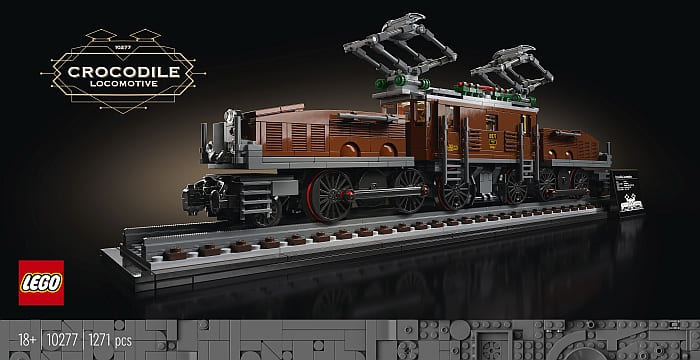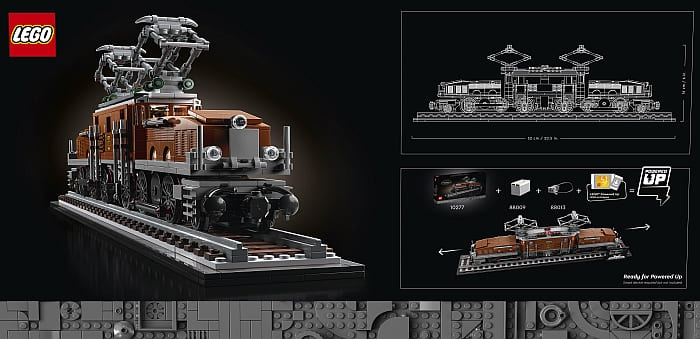There has been a lot of interest from the LEGO train fan community in the newly released #10277 LEGO Crocodile Locomotive set. We talked about the set in detail when the press-release became public (see: LEGO Crocodile Locomotive Coming!), and since then the designer-video was also released. In addition, some LEGO fans already purchased, built, and reviewed the set, so watching and/or reading their thoughts and hearing their opinion is another valuable resource.


Just to recap, the #10277 LEGO Crocodile Locomotive is based on a real-life electric locomotive from Switzerland. The name comes from the shape of the “noses” at each end of the locomotive, reminiscent of the snout of a crocodile. The nose units contain the motors and drive axles, and they are connected by an articulated center section with crew compartments, pantographs, and the transformer. The large motors were necessary for pulling heavy goods on the steep tracks of the Swiss mountains, and the pivoting center helped to make the tight curves of the alpine routes and tunnels. In the designer-video below, LEGO designer Pierre Normandin talks more about the real train, as well as the design process for the LEGO version.
The next two videos are from LEGO fan and reviewer JANGBRiCKS. He goes into detail about all the features and functions of the set, as well as the plusses and minuses about it. Some of the nice features that stood out for me the most are the easy of motorization, the subtle but nice shaping of the locomotive, the attractive design of the display track, and that all the decorations on the train are printed except for the sticker for the plaque. And I’m also really happy that the standard minifig accessory whip piece is now available in red because of this set!
As you heard from JANG in the review above, the the #10277 LEGO Crocodile Locomotive also has some negatives. In particular, the large gaps between the two nose sections and the center section and that the train tends to derail. These issues were also reported by other LEGO fans, so it was important to find some solutions. Fortunately JANG was able to solve both, and even more fortunately, the fixes are very simple. Watch the video below where he explains it all.
I personally like the set, and I like it even more after watching the designer-video and watching and reading reviews. And I’m also happy to hear that the fixes to improve the set are simple. It’s a pretty big locomotive though, so I haven’t decided yet if I will get it, but it has been sold out from the first day of its release anyway, so there is plenty of time to make a decision. If you’re interested in the set, you can put it on your Wish List and check back regularly on its availability status. It’s listed at the LEGO Creator section of the Online LEGO Shop.


What do you think? How do you like the LEGO Crocodile Locomotive? Are you planning to add it to your collection? Feel free to share your thoughts and discuss in the comment section below!
And you might also like to check out the following related posts:












Thanks for posting these. I like the train more and more. And I like Jang’s fix for the gap. He did a good job with that.
It’s growing on me too. Not every train has to be super colorful and fancy. This is a hard working train that gets the job done in the mountains!
I’m surprised it’s derailing so much without the fixes. That should have been caught before the release.
Jang said that if you have perfectly flat tracks and simple setup, the train shouldn’t derail. My guess is that lego has such a perfect setup at their office and didn’t notice the stress created by the distance of the wheels. I would be tempted to make the body a stud or two shorter or bring the wheels a little closer for a permanent fix.
Lego has a few trains with the rigging for some sort of overhead power supply. I’ve never seen this in real life other than street cars in major cities. Locomotives should have a diesel engine to generate the power. Is this a common site in non US countries?
I think electric locomotives are more common than diesel locomotives in Europe, where the infrastructure is often state-financed. They rarely look much like the Croco though, instead usually they look bulky or bullety.
If I’ve understood things correctly, as long as the electric infrastructure is in place, travelling itself should be much cheaper and greener than most alternatives.
Yes, indeed – electric locomotives are much more common in Europe. The share between diesel and electric locomotives there is roughly about fifty-fifty.
In Switzerland, where this train model originates from, virtually 100% of the train network is electrified and so are the locomotives (with a few exceptions).
By the way: this locomotive was first used in 1919 and can be seen as a successor to steam trains while the first diesel locomotive was built a few years later in 1925.
I don’t think I will get this one. It’s too different from the other trains, and it’s too big for my tracks. The designer did a great job, I’m not disputing that. It’s just not for me.
I’ve done a (I think) nicer gap closure mod. Bricklink Studio files for it as well as the part list are online.
Do you have a link to the studio file? Or how do I find it?
http://donald.van-de-weyer.net/LEGO/10277_Closing_the_Gap.zip